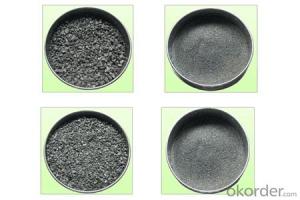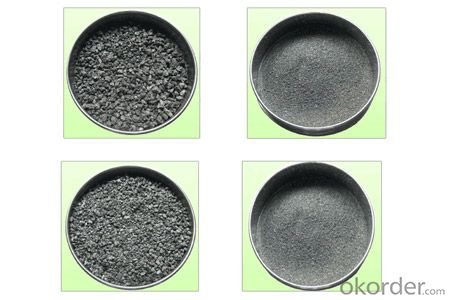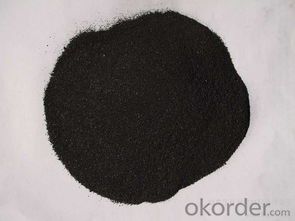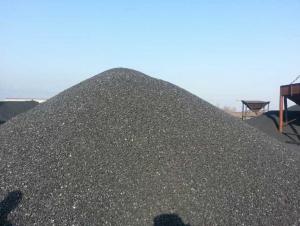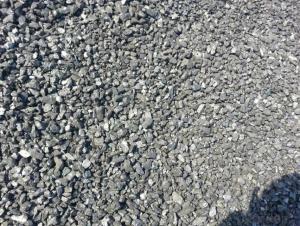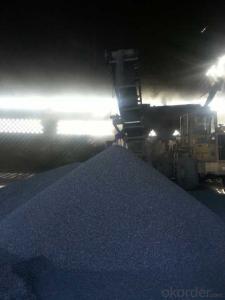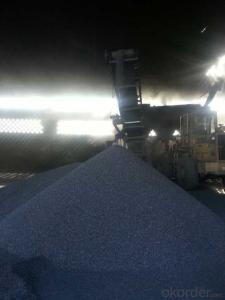FC93 RecarburIzer With High Purity And Good Service CNBM
- Loading Port:
- Tianjin
- Payment Terms:
- TT OR LC
- Min Order Qty:
- 0 m.t.
- Supply Capability:
- 100000 m.t./month
OKorder Service Pledge
OKorder Financial Service
You Might Also Like
Packaging & Delivery
Packaging Detail: | 25kgs/50kgs/1ton per bag or as buyer's request |
Delivery Detail: | Within 20 days after receiving corect L/C |
Specifications
Calcined Anthracite
Fixed carbon: 90%-95%
S: 0.5% max
Size: 0-3. 3-5.3-15 or as request
Feature
All of our goods are made in the best quality of world famous Tianjin. All of our products are with High carbon, Low ash, low sulphur, Low Moisture.
Application
The Calcined Anthracite Coal/Gas Calcined Anthracite Coal/Carbon Raiser is mainly used in steelmaking in electrical stove, screening water, shipbuilding sandblast to remove rust. It can reduce the cost of steelmaking effectively by replacing the traditional petroleum coke of carburant.Also can improve the Carbon content in steel-melting and Ductile iron foundry.
Specifications
Calcined Anthracite
Fixed carbon: 90%-95%
S: 0.5% max
Size: 0-3. 3-5.3-15 or as request
PARAMETER UNIT GUARANTEE VALUE | |||||
F.C.% | 95MIN | 94MIN | 93MIN | 92MIN | 90MIN |
ASH % | 4MAX | 5MAX | 6MAX | 7MAX | 8MAX |
V.M.% | 1 MAX | 1MAX | 1.5MAX | 1.5MAX | 1.5MAX |
SULFUR % | 0.5MAX | 0.5MAX | 0.5MAX | 0.5MAX | 0.5MAX |
MOISTURE % | 0.5MAX | 0.5MAX | 0.5MAX | 0.5MAX | 0.5MAX |
Size can be adjusted based on buyer's request.

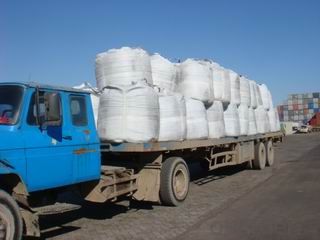
- Q: How does a kebab cook at home?
- The string label used (as with oil, burning flammable), placed below, then take a layer without burning the child, put carbon. The main thing is to make a gap between the fire and carbon. Then from the stove below the fan, let the fire go.
- Q: What is the carbon content of different types of soil?
- Various factors, such as climate, vegetation, and land management practices, can greatly influence the carbon content of different types of soil. Generally, soils with higher levels of organic matter exhibit higher levels of carbon. For instance, peat soils boast the highest carbon content among all soil types, ranging from 30% to 60%. These soils form in wetland areas where the decomposition of organic matter is hindered by water saturation, resulting in the accumulation of substantial amounts of carbon over time. Forest soils also tend to possess relatively high carbon content, typically falling between 1% and 10%. Forests continually supply organic matter through litterfall, contributing to the build-up of carbon in the soil. In contrast, agricultural soils generally exhibit lower carbon content compared to peat or forest soils. Factors such as crop rotation, organic amendments, and tillage practices influence the carbon content of agricultural soils. Consequently, the carbon content in these soils can range from less than 1% to around 6%. Grassland soils may have carbon contents similar to agricultural soils, depending on management practices. However, in undisturbed grasslands with high plant productivity, the carbon content can be relatively higher, ranging from 2% to 8%. In arid and desert regions, soils tend to display lower carbon content due to limited vegetation and slower rates of organic matter decomposition. Typically, the carbon content in these soils is less than 1%. It is important to acknowledge that these ranges are generalizations, and the carbon content of soil can vary both within and between soil types. Additionally, alterations in land use, such as deforestation or the conversion of grasslands to agriculture, can have a significant impact on soil carbon content.
- Q: What are fullerenes?
- Composed entirely of carbon atoms arranged in a spherical or cage-like structure, fullerenes represent a distinct category of molecules. Their discovery in 1985 sparked significant interest due to their intriguing properties and potential applications across various domains. The most extensively studied and renowned type of fullerene is buckminsterfullerene, also known as C60. This particular fullerene comprises 60 carbon atoms and takes on the form of a hollow sphere resembling a soccer ball. Fullerenes can also consist of varying numbers of carbon atoms, such as C70, C84, or even larger clusters. What sets fullerenes apart is their exceptional stability and distinctive structure. Carbon atoms within a fullerene form covalent bonds, creating a closed network of hexagons and pentagons. This configuration not only gives fullerenes their characteristic shape but also grants them remarkable mechanical, thermal, and chemical stability. Fullerenes possess an array of captivating properties that make them highly appealing for scientific research and technological advancements. They exhibit impressive electrical conductivity and can serve as efficient electron acceptors or donors in organic electronic devices. Additionally, they boast excellent optical properties, such as strong light absorption and emission, which have led to their utilization in solar cells and photovoltaic devices. Furthermore, fullerenes have demonstrated potential in medical and biological applications. Their unique cage-like structure allows for the encapsulation of other molecules within their hollow interior, making them ideal candidates for drug delivery systems. Fullerenes also possess potent antioxidant properties, making them viable contenders for various therapeutic treatments. To summarize, fullerenes represent an enthralling group of carbon-based molecules with distinctive structures and extraordinary properties. Their versatility and potential applications in electronics, energy, medicine, and other fields continue to be explored, rendering them an area of study that is both thrilling and promising within modern science.
- Q: What materials can be carbonitriding?
- Low temperature carbonitriding for high alloy tool steel, high-speed steel tools, etc., in temperature carbonitriding is under great pressure not only in carbon steel wear parts, high temperature carbonitriding is mainly used for medium carbon steel and alloy steel under great pressure.
- Q: How does carbon impact air quality?
- Carbon impacts air quality through the release of carbon dioxide (CO2) and other greenhouse gases during the combustion of fossil fuels. These emissions contribute to the greenhouse effect, trapping heat in the atmosphere and causing global warming. Additionally, carbon particles from incomplete combustion, like soot, can reduce air quality by causing respiratory issues and forming smog.
- Q: What is carbon offsetting in the travel industry?
- Carbon offsetting in the travel industry refers to the practice of compensating for the carbon emissions produced during travel activities by investing in projects that reduce or remove an equivalent amount of greenhouse gases from the atmosphere. As travel contributes significantly to global carbon emissions, carbon offsetting has emerged as a way for individuals and businesses to take responsibility for their environmental impact and strive towards more sustainable practices. When individuals or companies choose to offset their travel emissions, they calculate the carbon footprint of their trip based on factors like distance traveled, mode of transport, and fuel consumption. This calculation helps determine the amount of carbon dioxide equivalent emitted during the journey. To offset these emissions, they then invest in projects that reduce or remove the same amount of greenhouse gases from the atmosphere, such as renewable energy projects, reforestation efforts, or energy efficiency initiatives. The concept of carbon offsetting aims to achieve carbon neutrality, where the emissions produced are balanced by an equivalent reduction or removal of emissions elsewhere. By investing in offset projects, travelers and travel companies can effectively mitigate their environmental impact and contribute to overall efforts in combating climate change. Carbon offsetting in the travel industry not only helps reduce the carbon footprint of individual trips but also encourages the development of sustainable practices within the tourism sector. It provides travelers with the opportunity to minimize their environmental impact by supporting projects that promote renewable energy, conserve biodiversity, or improve local communities' livelihoods. However, it is essential to ensure that carbon offset projects are credible and deliver genuine emission reductions. Verified standards and certifications, such as the Gold Standard or Verified Carbon Standard, help ensure the integrity and transparency of offset projects. It is also important to prioritize efforts in reducing emissions directly, such as using more fuel-efficient transportation or opting for low-carbon alternatives, before relying solely on offsetting. In conclusion, carbon offsetting in the travel industry allows individuals and businesses to take responsibility for their carbon emissions by investing in projects that reduce or remove greenhouse gases. It is a proactive approach towards minimizing the environmental impact of travel and promoting sustainable practices within the tourism sector.
- Q: How does carbon dioxide affect ocean acidity?
- Ocean acidification, a process caused by the presence of carbon dioxide, is responsible for the increased acidity in the ocean. Human activities, such as the burning of fossil fuels, release carbon dioxide into the atmosphere, and a significant portion of it is absorbed by the oceans. This excess carbon dioxide reacts with seawater and forms carbonic acid, which then dissociates into hydrogen ions and bicarbonate ions. The rise in hydrogen ions reduces the ocean's pH level, resulting in increased acidity. The elevated acidity of the ocean negatively impacts marine life in several ways. Marine organisms, including corals, shellfish, and plankton, are unable to construct and maintain their calcium carbonate structures, such as shells and exoskeletons, due to this condition. This can lead to slower growth rates, weakened structures, and higher mortality rates among these organisms. The survival and reproduction of various species, including fish and other marine animals, are also affected by ocean acidification. The changes in water chemistry disrupt their physiological processes, making it difficult for them to navigate, find food, and evade predators. Moreover, the increased acidity can alter the behavior and development of certain species, potentially causing changes in ecosystems and a decline in biodiversity. Ocean acidification can also have a cascading effect on the entire marine food web. Phytoplankton and other primary producers, which are the foundation of the food chain, may suffer due to the changing ocean chemistry. Consequently, the organisms that rely on them for sustenance are also impacted. This disruption can have far-reaching consequences for the entire ecosystem, including commercially valuable fish species and the livelihoods of coastal communities that depend on them. In conclusion, the emissions of carbon dioxide contribute to ocean acidification, which has severe consequences for marine life and ecosystems. It is crucial to comprehend and address this issue in order to safeguard the health and sustainability of our oceans and the countless species that depend on them.
- Q: How does carbon affect the fertility of soil?
- Soil fertility relies on carbon, which has a significant impact on various soil properties and processes. The addition of carbon to the soil improves its structure and ability to hold water. Organic matter, abundant in carbon, serves as a food source for microorganisms. These microorganisms play a crucial role in nutrient cycling and soil aggregation as they break down organic matter into simpler compounds. This process releases essential nutrients that plants can readily access. Furthermore, carbon acts as a sponge, preventing the leaching of nutrients like nitrogen and thereby increasing their availability for plants. Additionally, soils rich in carbon have higher cation exchange capacity, enabling them to retain and release nutrients more efficiently. By maintaining and increasing soil carbon levels, we can enhance soil fertility, facilitate plant growth, and support sustainable agricultural practices.
- Q: How do you make your own carbon fiber bar?Know. ID is how to make? Don't copy anything that has nothing to do with it
- Carbon fiber rods, generally used in fishing rods, medical and construction fields, the molding process is pultrusion.Pultrusion: traction carbon fiber yarn (carbon fiber yarn is usually 12K, 24K based) impregnated epoxy resin, by heating 130 degrees or so, high temperature curing molding.Specific molding process can be consulted.
- Q: How are carbon fibers used in manufacturing?
- Carbon fibers are used in manufacturing for their exceptional strength, light weight, and high stiffness properties. They are commonly used as reinforcement materials in various industries such as aerospace, automotive, sports equipment, and wind energy. Carbon fibers are incorporated into composites to enhance the strength and durability of products, making them ideal for applications where weight reduction and structural integrity are crucial.
Send your message to us
FC93 RecarburIzer With High Purity And Good Service CNBM
- Loading Port:
- Tianjin
- Payment Terms:
- TT OR LC
- Min Order Qty:
- 0 m.t.
- Supply Capability:
- 100000 m.t./month
OKorder Service Pledge
OKorder Financial Service
Similar products
Hot products
Hot Searches
